Reported Speech Exercises: Unimontes-MG–2007
Skinny Barbie blamed over eating disorders
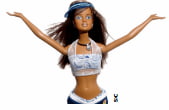
Barbie dolls may contribute to eating disorders in adolescence, according to new research. The study found that the Barbie dolls, which are far thinner than traditional shapes, particularly at the waist, make girls want to be unrealistically slim when they grow up.
The researchers from two British universities claim Barbie dolls could promote girls’ insecurity about their image, which in turn may contribute indirectly to insecurity and eating disorders later in life.
“These ultra-thin images not only lowered young girls’ body esteem but also decreased their satisfaction with their actual body size, making them desire a thinner body.”
Dr. Margaret Ashwell, science consultant and former director of the British Nutrition Foundation, said: “These results are very important and show that children can be influenced at a very early age. We need to be aware of that and take the appropriate action.”
The researchers say their findings suggest schools should educate the youngest children, as well as adolescents, about the risks of being too worried about having an “ideally” thin body shape. “Such programmes need to make girls aware that the thin beauty ideal is unattainable and unhealthy”, adds the study.
In the study, reported in the journal Developmental Psychology, the researchers from Sussex and the University of the West of England looked at the effects of images of two dolls on almost 200 primary school-age girls aged five to eight.
They were shown images of different figures, including Barbie and Emme, a new American doll whose body proportions represent a larger body shape. After they had been shown the images, the girls were asked to pick figures that represented their actual body shape, the body shape they ideally desired and their ideal body shape as an adult woman.
The difference between the shape girls thought they had and the shape they wanted was then analysed. The results showed that girls aged five to six were more dissatisfied with their shape and wanted more extreme thinness after seeing Barbie doll images than after seeing other pictures. For those aged six to seven the negative effects were even stronger.
A spokesman for Mattel, which manufactures Barbie, said: “Barbie allows girls to dream that they can be anything they want to be when they grow up. Barbie is not modelled in human scale and we will continue to talk to girls and mums and monitor their opinions.”
SPEAK UP. São Paulo: Editora Peixes, ano XIX, n. 234, Nov. 2006, p. 45. (Adapted).
Questão 01 sobre Reported Speech Exercises: O objetivo principal desse texto é;
A) mostrar como a Barbie pode ser prejudicial às meninas.
B) expor as causas dos distúrbios alimentares que afetam as garotas.
C) alertar para o consumismo que se inicia ainda na infância.
D) avaliar até que ponto a Barbie influencia positivamente as meninas.
Questão 02. O texto mostra que há uma preocupação no sentido de:
A) a boneca ser criada num modelo que não explore a forma física, o que ocorre com relação a outras bonecas.
B) as escolas instruírem as garotas sobre o perigo que está por trás da tentativa do corpo ideal.
C) a boneca ser feita com mais segurança, considerando que é usada por crianças pequenas.
D) as mães pararem de alimentar nas filhas a expectativa de que terão um corpo como o da Barbie.
Questão 03. O texto revela que a boneca Barbie:
A) tem induzido as adolescentes a questionarem o atual padrão de beleza, o qual escraviza a mulher.
B) tem interferido negativamente no comportamento das garotas, quando o assunto é a aparência.
C) tem reforçado o que a mídia prioriza: um corpo escultural.
D) tem disseminado o preconceito ao enfatizar a já existente aversão às bonecas mais rechonchudas.
Questão 04. Mattel, a fabricante da Barbie:
A) abre espaço para a criação de bonecas Barbie menos magras.
B) assegura que as garotas poderão ter um corpo como o da Barbie, se assim o desejarem.
C) explora o sonho das garotas, fazendo-as crer que são tão perfeitas quanto a Barbie.
D) diz que essa boneca dá às garotas a possibilidade de idealizarem o seu futuro.
Questão 05 sobre Reported Speech Exercises: “We need to be aware of that and take the appropriate action.”
A expressão of that, em destaque acima, faz menção, de acordo com o contexto:
A) às vantagens da alimentação saudável para o corpo.
B) aos resultados da ação dos nutricionistas.
C) aos efeitos obtidos com a intervenção das escolas.
D) à influência da Barbie sobre as garotas.
Cartoon A
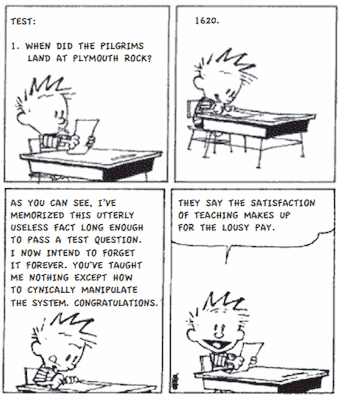
Available at: <http://progressiveboink.com/archive/calvinhobbes.htm>. Accessed: Apr. 13, 2010.
Questão 06. The MAIN aim of the text is to:
A) congratulate teachers on their job.
B) criticize the education system.
C) show how memory can be helpful.
D) teach students how to answer tests.
Questão 07. The word congratulations is used to:
A) blame the teacher for the way learning is treated at school.
B) congratulate the teacher for the students’ achievements.
C) disapprove the way the teacher manipulates the system.
D) encourage the teacher to keep teaching the way he / she does.
Questão 08. Consider the following cartoon:
Cartoon B
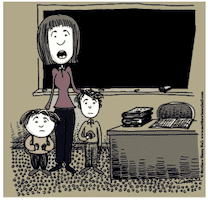
“Due to the rising costs of after-school care, my two sons will be running, jumping and screaming in the back of the classroom while I lecture. Thanks”
Available at: <http://www.insidehighered.com/views/tm/prof_momedited_jpg>. Accessed: Apr. 14, 2010.
Cartoon B is related to Cartoon A in the sense that both:
A) condemn teachers’ choices.
B) enrich teachers’ social roles.
C) illustrate teaching methods.
D) satirize teaching rewards.
Text I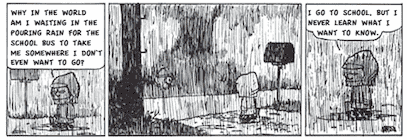
Available at: <http://www.gocomics.com/calvinandhobbes/-2009/12/04/>. Accessed: Apr. 12, 2010.
Questão 09. A problem commonly related to school and illustrated by the cartoon is the:
A) lack of real-life related studies.
B) scarce means of transportation.
C) students’ fear of going to school.
D) teens’ need of independence.
Reported Speech Exercises: Texto para as questões 10 e 11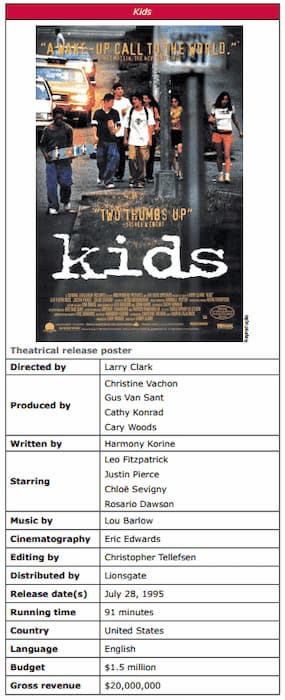
Kids is a 1995 American drama film written by Harmony Korine and directed by Larry Clark. The film features Chloё Sevigny, Leo Fitzpatrick, Justin Pierce, and Rosario Dawson, all of them in their debut performances.
The film is centered on a day in the life of a group of sexually active teenagers in New York City and their unrestrained behavior towards sex and substance abuse (alcohol and illegal drugs) during the era of HIV in the mid-1990s.
Available at: <http://en.wikipedia.org/wiki/Kids_(film)>. Accessed: Feb. 1st,2011.
Questão 10. De acordo com o anúncio anterior, o filme Kids;
A) custou mais de 20 milhões de dólares para ser produzido.
B) foi produzido e dirigido pela mesma pessoa.
C) foi produzido em 91 minutos.
D) arrecadou 1,5 milhão de dólares.
E) foi lançado em 1995 pela Lionsgate.
Questão 11 sobre Reported Speech Exercises: O filme trata de:
A) jovens alcoólatras e homossexuais.
B) um grupo de viciados em sexo.
C) adolescentes lutando contra o HIV.
D) jovens libertinos na era do HIV.
E) polêmica da discriminação da Aids.
🔵 >>> Veja também nossas outras listas de exercícios de Inglês.
Gabarito com as respostas do simulado com 11 Exercícios de Língua Inglesa sobre Reported Speech Exercises:
01. A;
02. B;
03. B;
04. D;
05. D;
06. B;
07. A;
08. D;
09. A;
10. E;
11. D
Doutorando em Genética e Biologia Molecular – UESC-BA
Mestre em Genética e Biologia Molecular – UESC-BA
Pós-Graduado em Metodologia do Ensino de Biologia e Química – FAEL
Licenciado em Ciências Biologias – IFMT/Campus Juína
